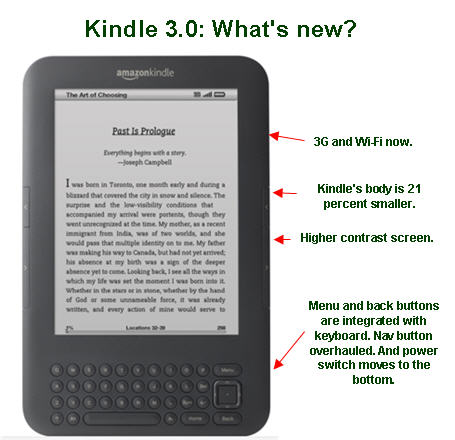Amazon unveils new Kindle; Assessing the e-reader fallout

Amazon on Wednesday launched its next-generation Kindle, which is faster, lighter and smaller. The move sets Amazon up for the holiday shopping season and puts pressure on rivals, notably Barnes & Noble as well as Sony, to create next-generation devices.
With the latest Kindle, Amazon is looking to take the offensive on pricing. Barnes & Noble's recent price cut put Amazon on its heels a bit. Now Amazon is launching a Wi-Fi-only Kindle for $139, $10 cheaper than the Wi-Fi-only Nook. A 3G/Wi-Fi Kindle will run you $189. There is also a sharp Kindle cover that includes a built-in reading light that runs off of the device's battery, but that'll set you back $59.99.
The revamped Kindle will be open for orders Thursday with shipments landing August 27.
So what's different with this Kindle? Amazon has made the Kindle 21 percent smaller. When you hold the device, it's clear that it's mostly screen. The Kindle is also 15 percent lighter than its predecessor and weighs in at 8.7 ounces, more than 3 ounces lighter than the Nook. Amazon also revved up the page speed, which turns pages 20 percent faster. Toss in double the storage and the next-gen Kindle is a nice upgrade.
Review: My 20 minutes with the latest Kindle
But there's that nagging Apple iPad question. Do we need a dedicated e-reader? Won't multi-purpose designs win the day? How important is E-ink and the ability to read outside? All of these questions are at play when you look into e-readers. First, the iPad and e-readers aren't a zero sum affair. And at the lower price points, the iPad, Amazon's Kindle apps and the Kindle may all be complementary. In fact, all Amazon cares about is selling the e-books. In the end, the debate about whether the latest Kindle is evolutionary, revolutionary or toast doesn't matter as long as Amazon keeps bolstering the e-book ecosystem and revenue associated with it.
I had a few minutes with the Kindle and have posted my review and the assorted moving parts with Amazon's latest device. For now, here's a look at the key Kindle points:
- The screen has 50 percent better contrast. Overall, the screen is very sharp---and still black and white.
- The Kindle is light and can be read with one hand easily.
- Kindle's page turning has sped up. Amazon in a statement touted its proprietary technology that has made page turning 20 percent faster. Amazon has better integrated its software and formatting with the E-ink technology.
- Amazon has streamlined the buttons for home and menu and integrated them with the keyboard. The buttons on the side are only for turning the page.
- There's a Webkit browser on the device, which is handy.
- Other features---PDF reader, store integration, passage sharing via Facebook and Twitter---will look familiar.
- The battery can last a month without 3G connected. With wireless, the battery will last you 10 days.
What will be interesting to watch is the reaction from e-reader rivals, the comparison with the iPad and the holiday shopping season economics. Amazon's move will step up competition as well as e-reader adoption. Here's a look at the moving parts:
The rival reaction
Amazon's move appears to be designed to get a jump on back-to-school shopping as well as the holiday season. Shipments will land just before school starts. Although Amazon's effort to make the Kindle DX the device for higher education has been pooh-poohed its $139 Wi-Fi Kindle may have some legs. Why? Wi-Fi is everywhere on campus, students will be looking to consolidate books and the price won't set parents back mRuss Grandinetti, vice president for Kindle content, said he expects the latest Kindle will be attractive to students---especially English and history majors that read mostly-text anyway.
Meanwhile, Amazon effort to make the Kindle lighter with a higher contrast screen may also put some pressure on e-reader rivals. The next-gen Kindle is heavier than the smartphone, but not by much at 8.7 ounces. Relative to theBarnes & Noble and Sony will have to respond for the holiday shopping season. For now Amazon has the higher ground on e-reader innovation. It's unclear whether page turn speed---something Amazon obsesses over---is a winning feature for consumers, but the company can definitely target the clunky software integration among rivals.
The iPad comparison
Although many folks see the iPad as a Kindle killer, Amazon begs to differ. Realistically, the Kindle and iPad are two different animals and classes of devices. Amazon's challenge: Convincing the masses that the Kindle is something different from the iPad.Let's face it. The Kindle isn't going to win a showdown with the Apple in a beauty contest. However, the two devices arguably shouldn't be on the same stage together.
Also: I confess: I bought an iPad (and so far I love it)
- Apple iPad Showdown: Battle of the eReader Apps
- eReader screen showdown: iPad IPS LED Backlit LCD versus e-Ink Displays
If Amazon can get you to bite on the latest Kindle, it will be happy to sync you up with its apps. The Kindle isn't perfect---you still want to touch the screen and would like some color---but now it isn't priced to be perfect. In fact, it wouldn't be all that surprising to see the Wi-Fi-only Kindle go for $99.99 once volume ramps up dramatically.
Kindlenomics
Earlier this year, the Yankee Group argued that the $150 price point will lead to an inflection point in e-reader adoption. The demand chart looks like a hockey stick once the devices get cheap enough.That day is here now. Amazon's macroeconomic argument is simple: It wants as many Kindles and apps out there to sell you more e-books. Amazon has the selection and content to win the e-commerce game. Amazon said last week that it is selling more e-books than hardcovers and that Kindle demand has surged at the $189 price. It remains to be seen if Amazon can maintain its Kindle sales pace, but new devices certainly won't hurt.
With Amazon's economic case out of the way, the decision to buy a new Kindle resides on your own microeconomics. A few factors to ponder (at least in my buying case):
Can you get by with the Wi-Fi-only version? Given my travel, I'm going to want a 3G option. One wild-card here is my smartphone choice. If I get a smartphone that serves as a Wi-Fi hot spot, I'm not going to care about 3G.
Price. Amazon's pricing for the Wi-Fi-only Kindle (as well as Barnes & Noble's Nook) changes the iPad conversation a bit. The Kindle is becoming the equivalent of a beach reader. If all you use it for is to read at the beach you can garner ROI at $139.
What's your use case? I've harped on this point before. I'm in a situation where the iPad doesn't consolidate much for me. The lighter Kindle is a valid pitch for me. You may want an integrated device. For me, the less expensive Kindle may make sense. I almost don't want to be distracted by a bunch of apps and a Web browser. I already multi-task too much now. Others, like Jason Perlow, would chuckle at this assumption and tout the iPad.
Related:
- E-reader and e-book topic page
- Amazon's e-book sales surge: Was it the Kindle or the iPad app?
- Amazon: Kindle sales accelerating; Demand tipping point?
- Kindle vs. Nook: The price war is on; E-reader shipments to surge?
- Top 10 new e-book readers
- Hands-on: B&N Nook is the king of connectivity and content
- Apple’s iPad vs. Amazon’s Kindle: It’s not zero sum
- Will Amazon cut Kindle prices to $149?
- Apple’s Best Buy distribution changes iPad unit calculus
- Apple iPad vs. Amazon’s Kindle: Consumers weigh the two devices
